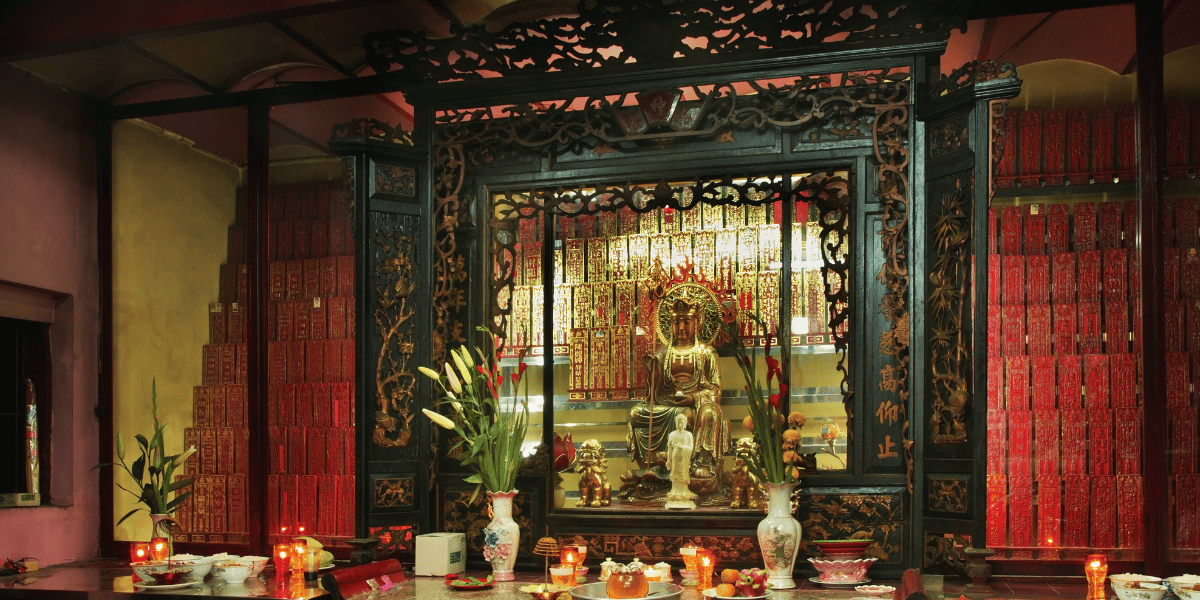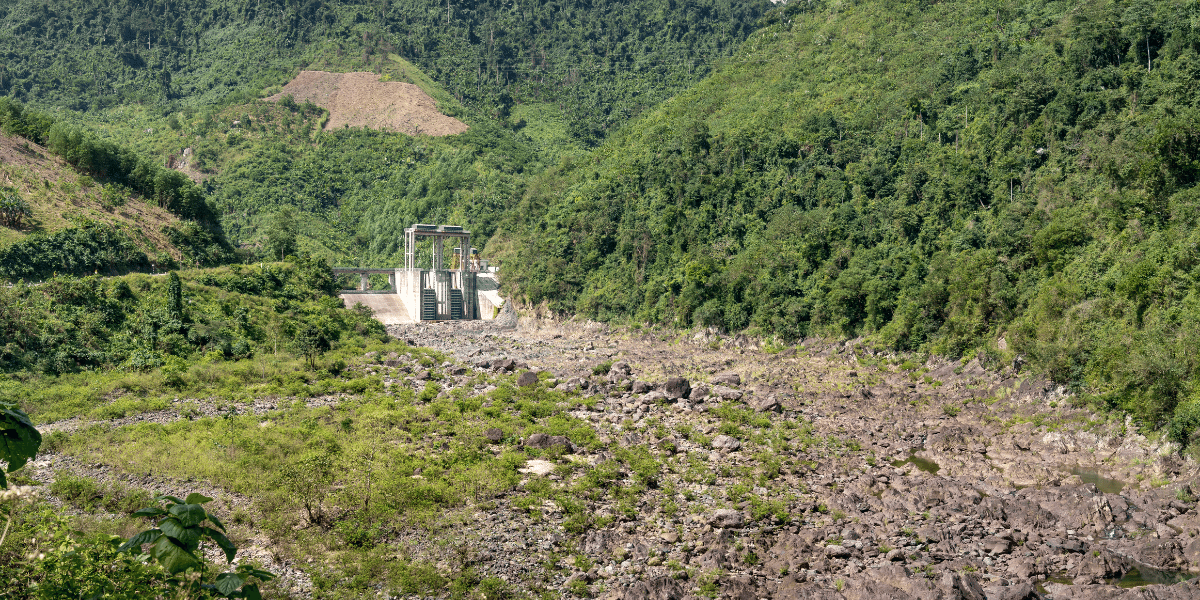The Jade Emperor Pagoda: A Masterpiece of Taoist Worship and Artistry in Vietnam
Last Updated on 26 January, 2025 by admin
Nestled in the bustling heart of Ho Chi Minh City, the Jade Emperor Pagoda (Chùa Ngọc Hoàng) stands as a remarkable testament to Taoist spirituality and artistic brilliance. Built in the early 20th century by the Cantonese community, this Taoist pagoda is both a place of profound worship and a treasured cultural landmark in Vietnam. Renowned for its ornate architecture, intricate wood carvings, and serene spiritual ambiance, the Jade Emperor Pagoda draws countless visitors, from devoted worshippers seeking blessings to curious tourists exploring the city’s rich history.
The pagoda’s design showcases traditional Taoist symbols, including dragon and phoenix motifs, vibrant ceramic tiles, and carvings depicting celestial beings. Within its prayer halls, the scent of incense and the soft murmur of prayers create a tranquil atmosphere that deeply connects visitors with Vietnamese Taoist culture. Its combination of religious significance and artistic craftsmanship makes the Jade Emperor Pagoda an essential destination for those seeking to delve into Vietnam’s spiritual heritage and cultural artistry.

Whether you’re drawn by its spiritual rituals, captivated by its architectural beauty, or curious to experience a piece of Vietnamese Chinese culture, the Jade Emperor Pagoda offers an enriching and unforgettable journey into Vietnam’s cultural tapestry.
Historical Background of the Jade Emperor Pagoda
Constructed in 1909 by Cantonese immigrants, the Jade Emperor Pagoda (Chùa Ngọc Hoàng) is a profound symbol of Taoist beliefs brought to Vietnam. Dedicated to the Jade Emperor (Ngọc Hoàng), the supreme deity in Taoism, the pagoda quickly became a significant spiritual hub for the Chinese-Vietnamese community in Ho Chi Minh City. Its establishment reflects the blending of Chinese spiritual traditions with Vietnamese cultural practices, creating a unique religious and cultural fusion.
Over the decades, the pagoda has stood as a testament to the enduring religious devotion of the community, with its Taoist rituals, intricate architecture, and sacred prayer halls offering a space for worship and reflection. Recognized today as a cultural heritage site, the Jade Emperor Pagoda plays a crucial role in preserving the Taoist traditions and stories of those who built it. This recognition not only honors its historical significance but also ensures that future generations can continue to connect with this spiritual landmark and its rich legacy.
Architectural and Artistic Features of the Jade Emperor Pagoda
Overall Design
The Jade Emperor Pagoda (Chùa Ngọc Hoàng) is a stunning representation of traditional Taoist architecture, featuring a vibrant red and green facade that symbolizes prosperity and harmony. Its layered roofs are adorned with intricate dragon and phoenix carvings, which represent strength, longevity, and the balance of opposing forces in Taoist philosophy. The pagoda’s overall layout reflects the cosmology of Taoism, emphasizing harmony between spiritual and earthly realms.
Statues and Altars
At the heart of the pagoda is the imposing statue of the Jade Emperor (Ngọc Hoàng), surrounded by intricately crafted figures of deities such as the God of Wealth and the Chief of Hell. Each statue is meticulously detailed, embodying the spiritual beliefs and legends of Taoism. The sacred altars are adorned with offerings, incense, and symbolic artifacts, creating an atmosphere of reverence and spiritual connection. Visitors often leave prayers and offerings here, further enriching the Taoist spiritual ambiance of the pagoda.
Woodwork and Artistry
The pagoda’s interiors are a showcase of masterful wood carvings, depicting scenes from Taoist legends and mythical creatures like dragons and celestial beings. These carvings not only enhance the beauty of the space but also narrate the spiritual stories that are central to Taoist beliefs. The use of traditional Chinese calligraphy and decorative ceramic tiles throughout the pagoda further highlights the exceptional craftsmanship of its builders, blending artistry with religious devotion.
Symbolism in Design
Every element of the pagoda is imbued with spiritual significance, from the incense-filled prayer halls to the detailed carvings and statues. These design elements create a harmonious space that symbolizes the connection between heaven and earth, reflecting the central principles of Taoist philosophy. Visitors to the Jade Emperor Pagoda are surrounded by this intricate symbolism, offering a profound spiritual experience and an appreciation of its artistic heritage.
The Jade Emperor Pagoda’s architectural and artistic features stand as a testament to the blending of Taoist spirituality and meticulous craftsmanship, making it a remarkable cultural landmark in Ho Chi Minh City and a source of inspiration for worshippers and tourists alike.
Religious and Cultural Significance of the Jade Emperor Pagoda
The Jade Emperor Pagoda (Chùa Ngọc Hoàng) continues to serve as a vital center of Taoist worship and spiritual devotion in Vietnam. Worshippers visit this sacred site to offer prayers for good fortune, health, and success, with deep reverence for the Jade Emperor (Ngọc Hoàng), the supreme deity in Taoism. The pagoda’s spiritual significance is especially evident during Lunar New Year and other important Taoist festivals, where vibrant rituals and ceremonies honor the gods and ancestors. These events fill the pagoda with a festive yet reverent energy, as devotees gather to celebrate and seek blessings for the year ahead.
Beyond its role as a religious sanctuary, the Jade Emperor Pagoda stands as a cultural bridge, embodying the harmonious blend of Vietnamese and Chinese traditions. Its integration of Taoist beliefs, Vietnamese spiritual practices, and artistic craftsmanship reflects the cultural diversity and interconnectedness of the region. For over a century, the pagoda has preserved and passed down these rich traditions, ensuring its spiritual and cultural legacy endures.
The Jade Emperor Pagoda’s cultural significance extends beyond worship, offering a space where both locals and visitors can connect with the region’s deep-rooted history and spirituality. It remains a timeless symbol of devotion, artistry, and cultural pride in Ho Chi Minh City.
Visitor Experience at the Jade Emperor Pagoda
Atmosphere and Activities
Stepping into the Jade Emperor Pagoda (Chùa Ngọc Hoàng) is like entering a sacred oasis, where the air is filled with the soothing scent of burning incense and the gentle murmur of prayers. The peaceful courtyards, shaded by ancient trees and adorned with stone benches, provide a serene space for reflection and an escape from the bustling streets of Ho Chi Minh City. Inside, the vibrant prayer halls offer a deep immersion into Taoist rituals, with glowing candles, colorful offerings, and worshippers bowing reverently before intricately decorated altars. During my visit, I was deeply moved by the spiritual ambiance and the devotion of those lighting incense and praying for good fortune, health, and success. Observing a local family honoring their ancestors gave me a deeper appreciation for the Taoist traditions that make this site so meaningful.
Photography and Exploration
The Jade Emperor Pagoda is a haven for photographers, with its ornate carvings, vividly painted statues, and intricate rooftop decorations featuring dragons, phoenixes, and other Taoist symbols. Each corner of the pagoda tells a story, whether it’s the majestic altar of the Jade Emperor or the smaller shrines dedicated to other Taoist deities, such as the God of Wealth or the Chief of Hell. I found the early morning hours to be ideal for exploration, as the pagoda is quieter, allowing you to capture the golden sunlight streaming through the carved windows—perfect for photographs of its stunning architectural details. Visiting during a Taoist festival provides an entirely different experience, with vibrant ceremonies, colorful decorations, and the pagoda illuminated by soft candlelight, creating an electric yet sacred atmosphere.
Practical Information
Conveniently located in District 1, the Jade Emperor Pagoda is a must-visit landmark for anyone exploring Ho Chi Minh City. The pagoda has no entrance fee, but small donations are appreciated to help maintain this historic site. Nearby attractions, such as the Saigon Notre-Dame Basilica and the War Remnants Museum, make it easy to include the pagoda in a day of cultural discovery. During my visit, I found the locals and staff to be welcoming, often happy to share stories and insights about the Taoist traditions and history of the pagoda. Whether you’re drawn by its spiritual significance, architectural beauty, or cultural depth, the Jade Emperor Pagoda promises an unforgettable experience that captures the essence of Vietnam’s religious heritage and artistic mastery.
Preservation and Modern Recognition of the Jade Emperor Pagoda
The Jade Emperor Pagoda (Chùa Ngọc Hoàng) remains a shining example of Vietnam’s dedication to preserving its religious and cultural heritage. As one of the most significant Taoist landmarks in Ho Chi Minh City, the pagoda is a vital center of Taoist worship and a treasured piece of the city’s history. Despite the challenges posed by the growing influx of tourists, ongoing efforts by local authorities and the community ensure that this cultural heritage site retains its charm and spiritual significance. Regular maintenance, conservation projects, and public education about its importance have been key to safeguarding the pagoda’s architectural and artistic features.
In 2016, the Jade Emperor Pagoda gained international recognition when former U.S. President Barack Obama visited the site during his trip to Vietnam. This historic visit elevated the pagoda’s profile as a global cultural landmark, drawing greater attention to its Taoist traditions, unique artistry, and spiritual legacy. Today, the pagoda not only serves as a sacred space for worshippers but also as an essential destination for travelers seeking to explore Vietnam’s religious and cultural diversity. Its continued preservation ensures that future generations can experience the profound spiritual ambiance and historical significance of this extraordinary site.
Conclusion
The Jade Emperor Pagoda (Chùa Ngọc Hoàng) is far more than a place of worship; it is a masterpiece of Taoist artistry and a powerful symbol of Vietnamese cultural pride. With its intricate architecture, vibrant Taoist symbolism, and profound spiritual significance, the pagoda stands as a testament to the enduring legacy of Taoist traditions in Vietnam. Its detailed carvings, sacred altars, and serene prayer halls invite visitors to immerse themselves in the rich history and cultural depth of this iconic Taoist pagoda.
Whether you’re drawn by a desire to explore Vietnamese Chinese culture, a fascination with its ornate artistry, or simply the chance to soak in the peaceful ambiance, the Jade Emperor Pagoda offers a truly unique experience. From observing Taoist rituals and admiring the Jade Emperor’s majestic altar to strolling through its tranquil courtyards, every moment spent at the pagoda leaves a lasting impression.
As one of Ho Chi Minh City’s most treasured landmarks, the Jade Emperor Pagoda is a must-visit for anyone seeking to connect with Vietnam’s religious heritage, marvel at its artistic mastery, or simply enjoy the serenity of this sacred space. Its combination of spiritual depth and cultural artistry ensures that it remains a captivating destination for worshippers and travelers alike.




